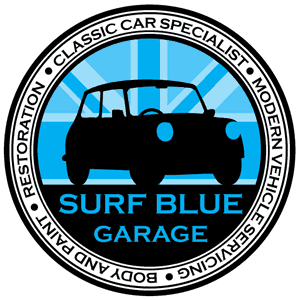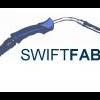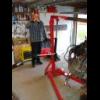Welding Advice
#1

Posted 21 November 2010 - 11:32 AM
I have an sip migmate 105 turbo and a big bottle of co2
My main concerns are
- is co2 right for the job? Ive heard people use argosheild and all sorts of other fancy gasses
- what guage metal should i be using for fabricating repair panels
- finding the right settings on my welder (anybody got the same one?)
#2

Posted 21 November 2010 - 12:04 PM
1mm plate is good for repairs in these areas, although i try and get 1.2mm for that little extra metal!
as for the settings you dont want it to high as you will blow holes, practice on some scrap of the same thickness until you get good welds
#3

Posted 21 November 2010 - 12:29 PM
co2 is upto the job, but doesnt give as clean weld as co2+argon mix
1mm plate is good for repairs in these areas, although i try and get 1.2mm for that little extra metal!
as for the settings you dont want it to high as you will blow holes, practice on some scrap of the same thickness until you get good welds
Im in a similar boat, i've got a welder and wire/gas etc, just need advice on setting the machine suitable for mini welding..
Currently, its on 1, and Min and wire feed on 1/2 ? is that correct
#4

Posted 21 November 2010 - 12:45 PM
Edit. Check out the mig welding forum for the wire feed modifications to the sip as the mechanism in them is crap,the mods make a world of difference.
Cheers Ross.
Edited by rosco454, 21 November 2010 - 12:46 PM.
#5

Posted 21 November 2010 - 05:09 PM
miggas is ideally the best to use (co2 +argon) but co2 is better for rusty metal so not far off when welding minis haha
ive got a little 90 amp that i have on max settings to weld mini panels together and its perfect you dnt need much power to weld minis together really or youll end up blowing stuff away.
#6

Posted 21 November 2010 - 06:11 PM
get as close gauge metal to original if you can (also makes it easier to weld when welding the same thickness of metal together)
miggas is ideally the best to use (co2 +argon) but co2 is better for rusty metal so not far off when welding minis haha
ive got a little 90 amp that i have on max settings to weld mini panels together and its perfect you dnt need much power to weld minis together really or youll end up blowing stuff away.
1) Why is Co2 better for welding rust?
2) Why are you welding rust?
3) Why are you using 90a to weld rust?
Even for pulse welding 50-60a is the most i use.
Rich
#7

Posted 21 November 2010 - 06:29 PM
2. read properly above
3.why ask such a dumb ass question. think about it a little... then make a sensible suggestion.
4. welders differ ALOT and my welder if prob different from your welder. the welder i use at work welding minis up nearly every day is set to between 3 and 4 on the settings on a 180 amp mig and has 6 settings.. this uses more than 90 amps most of the time.
#8

Posted 21 November 2010 - 09:17 PM
Another stupid question, how much gas pressure should i be using?? Thanks Rhys
#9

Posted 22 November 2010 - 08:44 AM
#10

Posted 23 November 2010 - 12:29 PM
1. co2 is a better gas for welding old ferous metals. i.e most panels that are fitted to minis arnt brand new im thinking and even tho they are not completly rotten they may be "rusty" this "rust can sometimes be cleaned off with such abrasives as flap wheels, finger file belts and so on. This panel which had "rust" on the surface on the panel that youve now cleaned up will stil contain some ferous oxides which in turn is called "RUST"
What? 100% Co2 in generally chosen because its far cheaper than a component built gas such as argoshield or another argon/co2 brand gas. Small amounts of oxygen are often added to smooth the weld surface further. A mixed gas even without the oxygen will give a far smoother weld, aswell as a far steadier arc on lower welding current, all in all perfect for mini bodywork. If your welding for a profession and not taking the materials your welding back to bare steel with no impurities on the surface, then you should be laying your torch down. Quite why the panels your welding are rusty (even surface rust) illudes me, unless your stripping them back to bare metal then waiting a few weeks before doing any work on them. And any ferrous oxides left in the panel after cleaning are not rust. The concentration of the oxides in the panel should be so small they have no effect on your welding what so-ever, and if it is then you should be cutting back more metal.
3.why ask such a dumb ass question. think about it a little... then make a sensible suggestion.
Whats there to think about? choosing your welding gas because of the way it reacts with the rusty surface your welding is bad practice no matter how you think about it.
4. welders differ ALOT and my welder if prob different from your welder. the welder i use at work welding minis up nearly every day is set to between 3 and 4 on the settings on a 180 amp mig and has 6 settings.. this uses more than 90 amps most of the time.
That they do, but a welder putting out 90a is a welder putting out 90a. Ive got a few welders, lincon at work, with digital readouts, and a clarke at home, at home, i use the clarke on 2 min, and aroud 50a on the lincons at work, about half of what your using, and even then thats on 1.2mm brand new steel, and i carnt run a full row of beads in one go, usually a couple of inches then rest, which is perfect to counteract panel warp anyway. However your guessing the output by the number of settings, if you had the manual then you could tell me the exact setting, because i can tell you now 90a onto a 1mm panel will make a hell of a mess, not to mention the amount of panel distorsion your going to do to a mini welding with that kind of heat.
Like yourself im a fabricator by trade, Mig, Tig and Arc.
Rich
#11

Posted 23 November 2010 - 01:19 PM
#12

Posted 23 November 2010 - 03:52 PM
Thanks for the help, and thanks for the info on the mod il be sure to sort that out. Can anyone advise me of the original thickness of the panels on a mini is around 1.0mm correct? I had some 1.5mm i tried welding with but just blew holes. I have a drivers floor pan corner, both rear arches to patch and a front damper mount to do. Hardly extensive. Il have a go with the co2 and see how i go.
Another stupid question, how much gas pressure should i be using?? Thanks Rhys
Most mini panels are 0.9mm thick with the rear heel board and front bulkhead cross member being 1.2mm thick. As a general rule of thumb i have always used my gas setting as a gentle hiss from the torch no specific pressure setting on a gauge.
Obviously the higher the setting the quicker you will use your bottle contents. If you are paying for it yourself then this can get expensive.
If you are under cover ie in a garage then this will be fine but if you work outside and it gets a tad windy then you will need more gas pressure to prevent losing the gas shielding.
Personally i have used CO2 for many years and only recently gone over to Argo shield light. The CO2 i always used was from pub gas bottles and worked fine but due to recent changes in legislation getting hold of these bottles is now too difficult which is why i use B.O.C for my Argo Shield Light.
There have been quite a few threads on the forum with regards to different gases and welder types power settings etc so it is always worth having a search to see if you can find the info you need that way.
My personal choice for all of the above and after welding my sons project over the last year and a bit it all works well for me.
By the way i use a Clarke 135 TE Turbo with .6mm wire on a wire feed speed of between 6 & 7 for low to medium power setting welding and wire speed 9 for high power settings. Again my choice and works well for me.
1 user(s) are reading this topic
0 members, 1 guests, 0 anonymous users
















